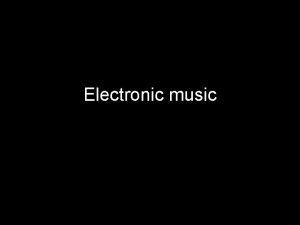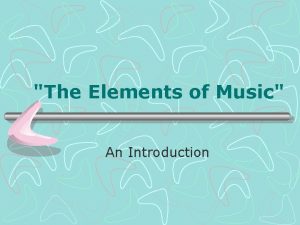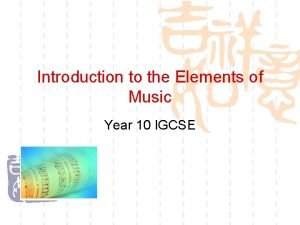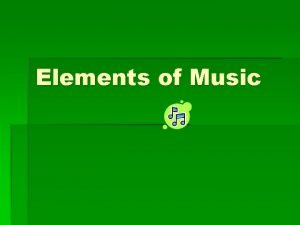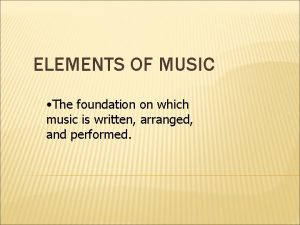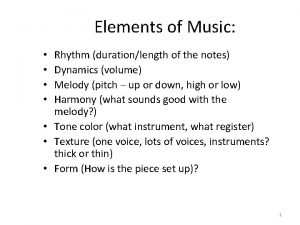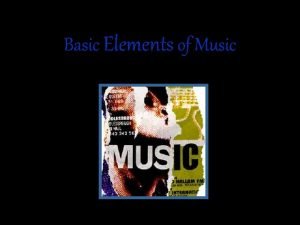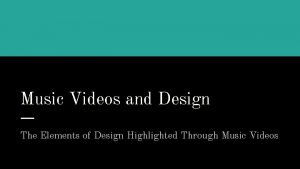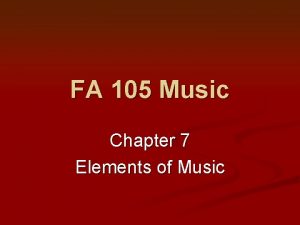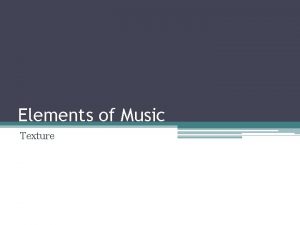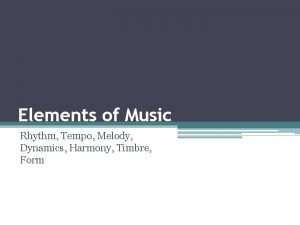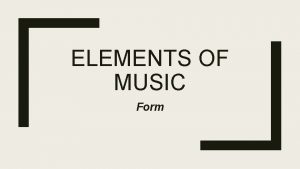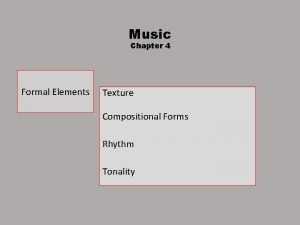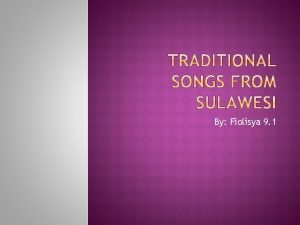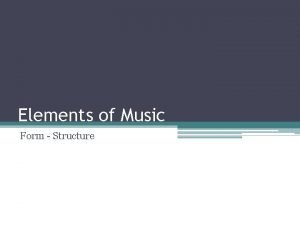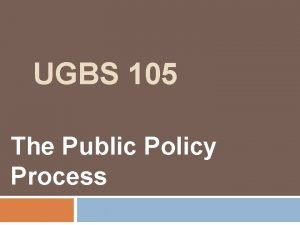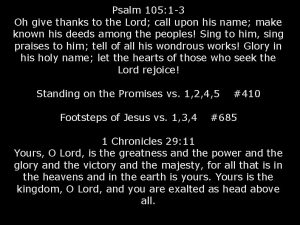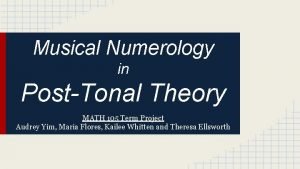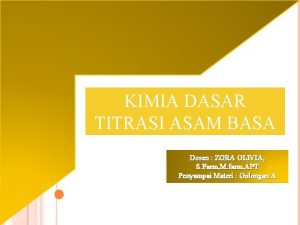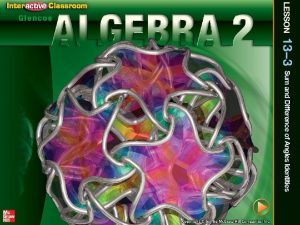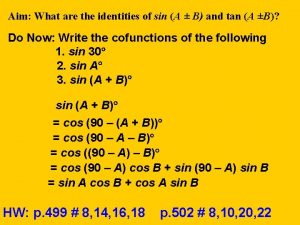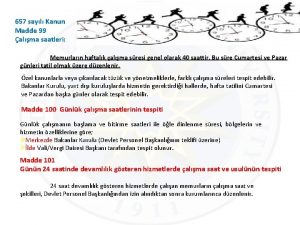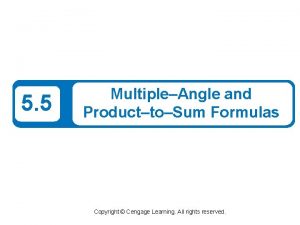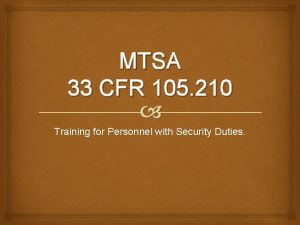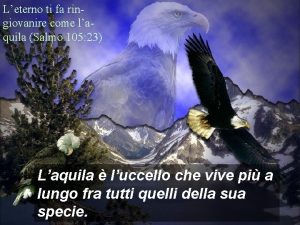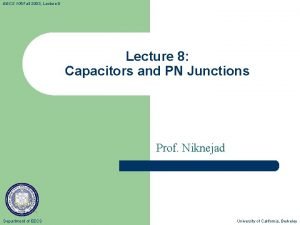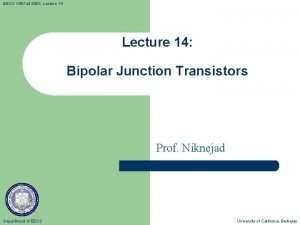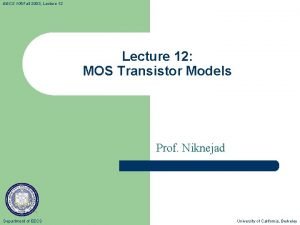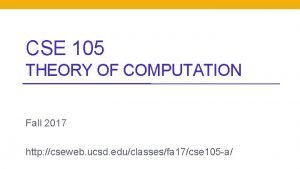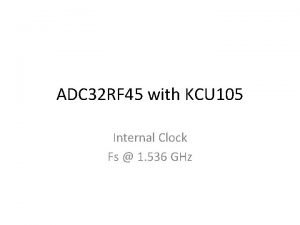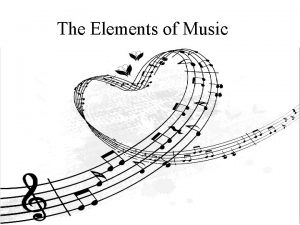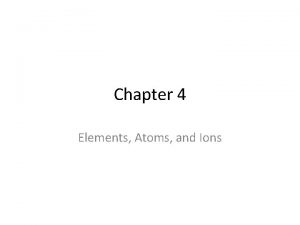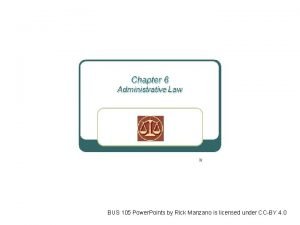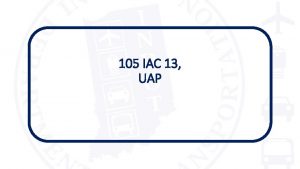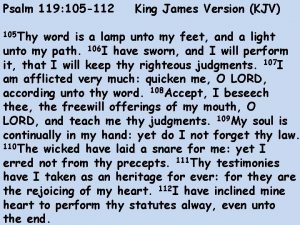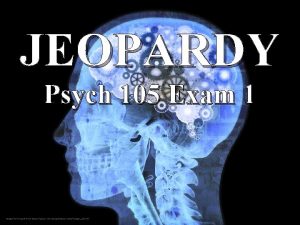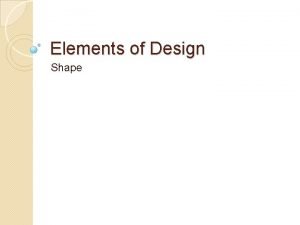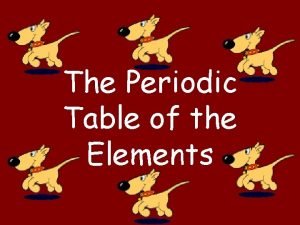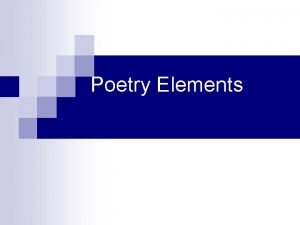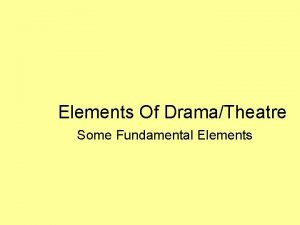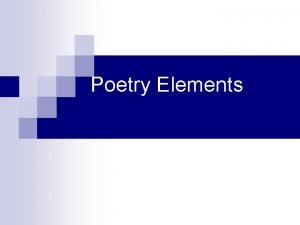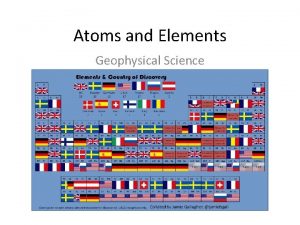FA 105 Music Chapter 7 Elements of Music



















































- Slides: 51

FA 105 Music Chapter 7 Elements of Music

Elements of Music n Melody n Rhythm n Harmony n Dynamics n Timbre n Texture n Form

Elements of Music Melody n Rhythm n Harmony n Dynamics 1. A Musical Sentence 2. A Meaningful n Timbre Sequence of individual pitches n Texture n Form n

Elements of Music Names Given to Notes Melody • Westernn. Tradition • ABCDEFGA • Western Tradition • Do Re Mi Fa Sol La Ti Do • Music of India • Sa Re Ga Ma Pa Dha Ni Sa

Elements of Music Melody n Pythagoras n Experimented with string n Touched in the middle – vibrated twice as fast n Touched in different proportions gave different pitches n Established a series of notes based on mathematical proportions which became the basis for our modern scale http: //aboutscotland. co. uk/harmony/prop. html

Elements of Music Melody n All seven notes in an octave creates a scale n n Scales are the building block for all melodies When played from C to C (labeled as a “major scale”), all of the notes are not the same distance or interval apart. ½ Step C D E F ½ Step G A B C

Elements of Music Melody n Musical Notation Over the years, composers have developed a way to indicate intended pitches. Music Staff – 5 lines and 4 spaces used to display notation n Lower pitches (slower vibrations) are indicated toward the bottom of the staff. Higher Pitches n Higher pitches are indicated toward the top. n Lower pitches

Elements of Music Melody Leger Lines extend the staff

Elements of Music Melody n Melody can be Short and simple n Long and elaborate n A theme or motif n Conjunct n Disjunct n

Elements of Music Melody n Melodic Contour n The direction and “shape” of the melody.

Elements of Music n Melody n Rhythm n Harmony n Dynamics n Timbre n Texture n Form

Elements of Music n Melody n Rhythm The organization of sound in time. n Harmony Morning Routine n Dynamics Heartbeat Planning Trips Breathing n Timbre Wear a Watch Ebb & Flow of Tides Spend time sleeping!n Texture. Cycle of the Moon Eat at certain intevals of time Cycle of the Sun n Form

Elements of Music Rhythm n Rhythm concepts n Beat – The pulse of the music n Can be very strong or very subtle n Tap foot or clap hands to the beat n Meter – pattern of rhythmic emphasis n Originally organized similar to “poetic feet” in English Iamb Trochee Anapest n Duple Meter 2 4 4 4 Dactyl Spondee Triple Meter 3 4

Elements of Music Rhythm n Note Values – shape of the note implies relative amount of time for sound n Based on Fractions – Whole note…divide by 2 = half note…divide by 2 = quarter note…etc.

Elements of Music Rhythm n Tempo – the Speed of the Music Might remain constant…might change n Some words associated with Tempo n n Allegro – fast n Adagio – slow n Andante – walking tempo Vivace – very fast Syncopation – Emphasis on “weak” beats or “off-beat. ” n Example of Syncopation

Listening My Arts Lab Examples n n n Test Seven Nocturne No. 2 (in E-flat Major, Op. 9) Chopin Meditation From Thais Massenet Symphony No. 9 (in D Minor) Ode to Joy Beethoven Adagio in G Minor (for Strings) Giazotto My Arts Lab #1 – -Animated Notation as needed -Closer Look – Chamber Ensemble -Closer Look – Mega-Orchestra #2 – -Videos – How an Orchestra Works: Brass -How an Orchestra Works: Strings -How an Orchestra Works: Woodwinds

Elements of Music Melody n Rhythm n Harmony n Dynamics n Timbre n Texture n Form n

Elements of Music Melody n Rhythm Harmony • Harmonyn–Harmony notes sounding at the same time n Dynamics • A chord isn two or more notes Timbre sounded together n Texture • A triad is na Form chord of 3 notes that n are an interval of a third apart

Elements of Music Harmony Triads G E C C E G C A F F D B G A G C B D

Elements of Music Harmony n Music does not always have harmony Medieval Era – church did not allow use of harmony or rhythm…only melody n Melodies added on top of original – harmony resulted n Functional harmony – priority of certain chords n Tonic chord – triad built on tonic note n

Elements of Music Harmony n Harmony can be defined as n n Consonant – “pleasing” Dissonant – “harsh” Harmonic Cadence – same idea as a melodic cadence, that is, a point of rest or relaxation; a musical “punctuation mark” n Our culture (and our favorite music) has harmonic expectations n n Branch out to other music

Elements of Music Melody n Rhythm n Harmony n Dynamics n Timbre n Texture n Form n

Elements of Music Melody n Rhythm Harmony • Texture –n. Similar to art, texture is the “thickness” of the music, n Dynamics or how many layers exist in the n Timbre music. n Texture n Form n

Elements of Music Texture Jump to illustration Monophonic – consists of a single melody, no harmony n Homophonic – two types n A single melody accompanied by harmony n Although there is one melody, all other voices move together, as in a hymn n n Polyphonic – two or more equally important melodies played at the same time.

Elements of Music Texture n Monophonic – a single line Back

Elements of Music Texture n Homophonic – First type, melody with accompaniment.

Elements of Music Texture Melody Accompaniment n Homophonic – Second type, hymn like; all voices move together, one has Back melody.

Elements of Music Texture n Polyphonic – Two or more equal melodies occurring at the same time.

Elements of Music Texture n Examples of Texture Monophonic n Homophonic n Polyphonic n Hallelujah Chorus – All three occur somewhere in the piece n

Elements of Music Melody n Rhythm n Harmony n Dynamics n Timbre n Texture n Form n

Elements of Music Melody n Rhythm n Dynamics – Relative loudness of n Harmony the music Dynamics n Dynamics – Music can be loud n Timbre – Music can be soft n Texture – Music can grow louder n Form – Music can diminish n

Link to Website Elements of Music Dynamics

Elements of Music Dynamics n Different levels of loudness Pianissimo – Very soft n Piano – Soft n Mezzo Piano – Medium soft n Mezzo Forte – Medium loud n Forte – Loud n Fortissimo – Very loud n

Elements of Music Dynamics n Music can also grow louder or softer. Crescendo – grow louder or cresc. n Decrescendo – grow softer or decresc. n Diminuendo – diminish, grow softer dim. n

Elements of Music Dynamics n Loudness is measured in decibels (d. B). Source Intensity Level Threshold of Hearing 0 d. B Lawnmower 90 d. B Rustling Leaves 10 d. B Large Orchestra 98 d. B Water Dripping 20 d. B Snowmobile, Chainsaw 100 d. B Whisper 30 d. B Walkman at Maximum Level 100 d. B Quiet Radio in Room 40 d. B Front Rows of Rock Concert 110 d. B Moderate Rainfall 50 d. B Jet Plane Takeoff 120 d. B Conversation, Dishwasher 60 d. B Threshold of Pain 130 d. B Busy Street Traffic 70 d. B Military Jet Takeoff 140 d. B Vacuum Cleaner, Alarm Clock 80 d. B Instant Perforation of Eardrum 160 d. B

Elements of Music Dynamics n Loudness is measured in decibels (d. B). • A typical conversation occurs at 60 d. B - not loud enough to cause damage. • A bulldozer that is idling (note that this is idling, not actively bulldozing) is loud enough at 85 d. B that it can cause permanent damage after only 1 work day (8 hours). • When listening to music on earphones at a standard volume level 5, the sound generated reaches a level of 100 d. B, loud enough to cause permanent damage after just 15 minutes per day! • A clap of thunder from a nearby storm (120 d. B) or a gunshot (140 -190 d. B, depending on weapon), can both cause immediate damage.

Elements of Music Melody n Rhythm n Harmony n Dynamics n Timbre n Texture n Form n

Elements of Music Melody n Rhythm n Harmony n Timbre is that quality which distinguishes n Dynamics one instrument or voice from another. n identify Timbrethe difference between n If we can n Texture a flute, an oboe, and a trumpet all playing the samen note, Formthat is distinguishing different timbres. n

Elements of Music Timbre n Voice Parts 1 st level – women (high) or men (low) n 2 nd level n n Women – Soprano (high) or Alto (low) n Men – Tenor (high) or Bass (low) n 3 rd level n Soprano – Mezzo Soprano, Lyric Soprano, Coloratura, Dramatic Soprano, Spinto Soprano n Alto – Alto, Contralto n Tenor – Lyric Tenor, Countertenor, Dramatic Tenor n Bass – Baritone, Basso Profundo, Bassbaritone, Basso Cantante

Elements of Music Timbre Sound produced by vibrating an air Aerophones column Sound produced by vibrating a Chordophones string Membranophon Sound produced by vibration of a es stretched membrane Sound produced by the vibration of Idiophones the body of the instrument Sound produced by oscillating Electrophones electrical circuit

Elements of Music Timbre Aerophones Woodwinds, Brass, Pipe Organ Chordophones Strings, Piano, Harp, Guitar, Banjo Membranophon Snare Drum, Bass Drum, Timpani, es Congas, Bongos Bells, Xylophone, Marimba, Idiophones Cymbals, Triangle, Temple Blocks Synthesizer, MIDI Guitar, MIDI Electrophones Drums, MIDI Wind Controler

Elements of Music Timbre n Strings – Orchestra – Violin, Viola, Cello, Bass (Double Bass) Piano, Harp n Band – Sometimes Piano, Harp n Rock Bands – Guitar, Bass, Piano n Country Bands – Guitar, Steel Guitar, Bass, Banjo, Mandolin n

Elements of Music Timbre n Woodwinds Orchestra – Flute, Piccolo, Oboe, English horn, Clarinet, Bassoon, Contrabassoon n Band – Same, plus Alto, Tenor, and Bari Saxophone n Jazz Band – Saxophones, doubles of flute, clarinet, etc. n Popular Music - Saxophones n

Elements of Music Timbre n Brass Orchestra – Trumpet, Horn, Trombone, Tuba n Band – Trumpet, Horn, Trombone, Euphonium (Baritone), Tuba n Marching Band – Some specialized brass – Mellophone, Sousaphone, Marching Euphonium n Jazz Band – Trumpet, Trombone, Flugelhorn n Popular – Trumpet, Trombone n

Elements of Music Timbre n Percussion Orchestra – Snare Drum, Bass Drum, Timpani, Xylophone, Marimba, Orchestra Bells, Celesta, Chimes, Cymbals, Triangle, Cabasa, Guiro, Slap Stick, Wind Machine, Marching Machine, etc, etc! n Band – Same n Jazz Band – Drum Set, Auxiliary instruments, Latin Instruments n Marching Band – Marching Snare, Quints (Quads, Trios), Tonal Bass Drums, plus all above n

Elements of Music Timbre n Orchestra n Jazz Band n Concert Band

Elements of Music Timbre Chamber Groups – Small groups of instruments n Standard Chamber Groups n Woodwind Quintet – Flute, Oboe, Clarinet, Horn, Bassoon n Brass Quintet – 2 Trumpets, Horn, Trombone, Tuba n String Quartet – 2 Violins, Viola, Cello n Many others – Clarinet Choir, Brass Choir, Bassoon Quartet, Trumpet Choir, Horn Choir, n

Elements of Music Melody n Rhythm n Harmony n Dynamics n Timbre n Texture n Form n

Elements of Music Melody n Rhythm n Form is how the music is put n Harmony together n Dynamics n Three concepts of form n Timbre n Repetition n Texture n Contrast n Form n Variation n

Elements of Music Form n To indicate the form, musicians use letters n n n Capital letters for large sections (ABCDE) Lower case letters for small sections (abcde) Superscript to indicate similar music (A’ or A 1) Example: 3 large sections, the first and third are the same music, the second is different A B A Example: 5 large sections, the first, third, and fifth are the same music, second and fourth are different A B A C A

Elements of Music Form n Three concepts of Form Repetition – repeat previous music AA n Contrast – different from previous music AB n Variation – similar to previous music AA’ n n All music can be described with one of these three terms
 Music music music
Music music music Monophonic texture
Monophonic texture Romantic vs classical music
Romantic vs classical music Music that employs electronic music
Music that employs electronic music Ilocano name for the wind instrument
Ilocano name for the wind instrument Elements and principles of art
Elements and principles of art Elemts of music
Elemts of music Introduction to the elements of music
Introduction to the elements of music Elements of musics
Elements of musics Tchaikovsky is known primarily for his ballets. true false
Tchaikovsky is known primarily for his ballets. true false Rhythm vs melody
Rhythm vs melody 8 elements of music
8 elements of music Mad t-shirt music
Mad t-shirt music 8 elements of music
8 elements of music Elements of a music video
Elements of a music video The 7 elements of music
The 7 elements of music Definition of texture in music
Definition of texture in music It is the speed of the beat, the basic pace of the music.
It is the speed of the beat, the basic pace of the music. Elements of form in music
Elements of form in music Formal elements of music
Formal elements of music Si patokaan in english
Si patokaan in english Music reflect
Music reflect Ugbs 105
Ugbs 105 118/105
118/105 Dbhds incident reporting
Dbhds incident reporting Psalms 119:105 nlt
Psalms 119:105 nlt Luke 14:25-35 esv
Luke 14:25-35 esv Prime numbers of 117
Prime numbers of 117 105 numerology
105 numerology Gst 105
Gst 105 Berapakah volume 0 105 m hcl
Berapakah volume 0 105 m hcl Ge 105
Ge 105 Cos 120 exact value
Cos 120 exact value Fas 130
Fas 130 Exact value of sin 105°
Exact value of sin 105° 657 99. madde
657 99. madde Exact value of sin 105°
Exact value of sin 105° Psaume 119 signification
Psaume 119 signification 33 cfr 105
33 cfr 105 Salmo 105:1
Salmo 105:1 Eecs 105
Eecs 105 Eecs 105
Eecs 105 Eecs 105
Eecs 105 Cse 105 ucsd
Cse 105 ucsd Kcu 105
Kcu 105 105 m x 68 m
105 m x 68 m 105/7 simplified
105/7 simplified Cs 105 iit
Cs 105 iit Jon hanrath
Jon hanrath Especialidad 105
Especialidad 105 Bloeddruk normaal
Bloeddruk normaal Penanganan url dalam android meliputi
Penanganan url dalam android meliputi



